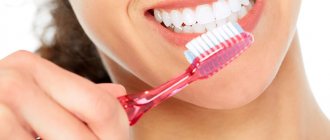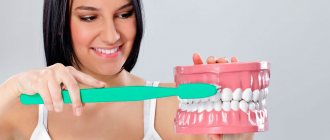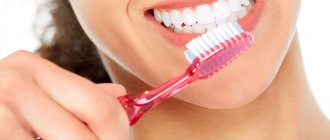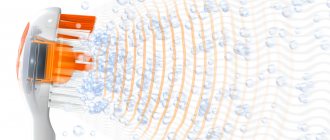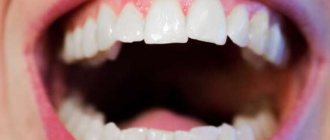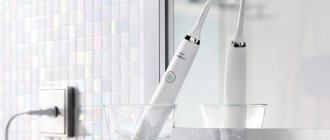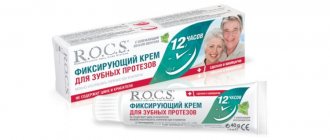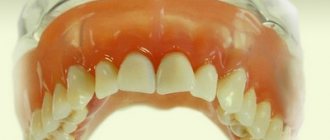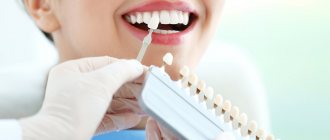From this article you will learn:
- how effective is an ultrasonic toothbrush - reviews from dentists,
- ultrasonic toothbrushes – price, rating 2022.
The article was written by a dentist with more than 19 years of experience.
An ultrasonic toothbrush is one of the options for electric toothbrushes, and it is distinguished by the presence of a generator of ultrasonic waves, which loosens and removes plaque. Ultrasonic vibrations from the generator are transmitted to the bristles of the working brush head, causing them to vibrate at a frequency of 96,000,000 vibrations per minute. A special feature is that ultrasonic vibrations can propagate from the tips of the bristles deep into the tissue (about 5 mm).
Ultrasonic vibrations help weaken the attachment of pigment and microbial plaque to tooth enamel, i.e. contribute to its loosening. In addition, the penetration of ultrasound into tissues by 5 mm (from the point of contact of the bristles with the tooth surface) should ensure therapeutic effectiveness even in the depths of periodontal pockets and interdental spaces. It sounds good – especially for patients with gum disease, but in reality everything is not so rosy.
Ultrasonic brush: photo
The first ultrasonic toothbrush appeared in 1992, and it was produced under the Ultrasonex® brand (USA). Initially, this toothbrush contained only an ultrasound generator, but a few years later the manufacturer launched an improved model on the market, which, in addition to the ultrasound generator, also had a motor that generates sound waves. And at the moment there are ultrasonic toothbrushes that can work only due to ultrasound, or due to a combination of ultrasonic and sound vibrations.
In addition, you must distinguish ultrasonic toothbrushes from sonic ones (for example, such as Philips Sonicare, Donfeel or Xiaomi Soocas). These brushes do not have an ultrasonic generator, but only a motor that generates sound vibrations of the bristles - on average, usually somewhere from 20,000 to 40,000 vibrations per minute, but some advanced models produce even 60,000 vibrations per minute. Thus, the bristles of sonic toothbrushes make significantly fewer oscillations per minute (compared to ultrasonic ones), but the amplitude of the oscillatory movements will be greater.
Important: many manufacturers deceive consumers by calling their sonic toothbrushes ultrasonic. For example, if you see a product like “Xiaomi Soocas Ultrasonic Toothbrush” in an online store, then know that it is actually a sonic brush. It should be noted that there is a huge range of sonic toothbrushes, but only a few models of ultrasonic brushes are sold in Russia. And we have listed them below –
- Megasonex m8,
- Emmi-dent 6 Professional,
- Emmi-Dent 6 Platinum.
How does an ultrasonic toothbrush work?
An ultrasonic toothbrush contains a piezoceramic plate located under the bristles of the toothbrush head. This plate emits an ultrasonic vibration wave with a frequency of 1.6–1.7 MHz. Thanks to this, the bristles on the head of the toothbrush make about 100,000,000 oscillatory movements per minute. Below you can see how the Megasonex ultrasonic toothbrush works.
Operation of the Megasonex ultrasonic brush (video 1) –
We have already said above that the piezoceramic plate generating ultrasound is located in the head of each replaceable nozzle (right at the base of the bristles). The nozzle must be changed - at least once every 3 months, even without visible wear of the bristles of the replacement nozzle. This is due to the fact that during the operation of the nozzle, the piezoceramic plate wears out, and over time, the power of the ultrasound generated by it decreases.
Differences between sonic toothbrushes –
Sonic-type brushes generate oscillatory waves not in the ultrasonic range, but in the sonic range (i.e. their frequency is much lower). Therefore, their bristles make a much smaller number of oscillatory movements - on average from 20,000 to 40,000 per minute, and some of the most advanced models up to 60,000 vibrations per minute. At the same time, we once again draw your attention to the fact that the amplitude of the oscillatory movements of the bristles of sonic brushes will be greater than that of ultrasonic brushes, and this is clearly visible when comparing the two videos.
Operation of the Xiaomi Soocas sonic brush (video 2) –
Important: the operation of a sonic toothbrush in water looks more impressive than the Megasonex ultrasonic toothbrush. The flow of liquid and microbubbles are formed more actively here, but a glass of water is just a glass of water, and not the oral cavity. The fact is that when brushing your teeth, there will never be such a volume of liquid in your mouth that the oscillating bristles can drive it so intensely through the interdental spaces. In general, this test is far from practical, but it clearly demonstrates the difference in the amplitude of vibration of the bristles of sonic and ultrasonic toothbrushes.
When considering the purchase of an ultrasonic toothbrush, remember that these devices definitely cannot be used by pregnant women, cancer patients, patients with diabetes, and patients with pacemakers.
What important characteristics should you pay attention to when choosing an electric toothbrush?
Keep in mind! When choosing an electric toothbrush, it is important to take into account several criteria:
- Cleaning head size. Its area should cover no more than two incisors. This parameter varies from 1.3 to 1.6 cm.
- Cleaning head shape. It is better to opt for a brush with a round head. It allows you to approach the back molars and clean out any food debris that has accumulated between them.
- Number and type of bristles. The head of a brush intended for cleaning the teeth of an adult must have at least 55 tufts of bristles. As for the shape, upon closer examination they should be somewhat pointed. It is this form that allows you to remove plaque and efficiently clean the interdental spaces.
- Hardness level. If you suffer from tooth sensitivity, choose a brush with soft bristles. Likewise, if you have plastic dentures or veneers installed. In other cases, you can give preference to a brush with medium-hard bristles. A rigid attachment can only be used with the permission of the attending physician.
- Auxiliary attachments and additional functions. Some manufacturers add auxiliary attachments to the basic brush set: massage, whitening, polishing, anti-plaque, and for sensitive gums. Here you need to proceed from your own needs and the recommendations of the dentist. Often, special attachments are needed for those who wear braces, dentures, implants, or have significant problems with their bite.
- Type of head movement. According to dental research, the best option for most users is brushes with a reciprocating type of head movement. Such devices gently remove dirt. If the brush head pulsates, cleaning time decreases and efficiency increases. Ideally, you should find a brush that combines both technologies.
- Pressure meter. Allows you to avoid excessive pressure on the enamel. Some brushes automatically turn off if the user presses too hard on the teeth.
- Cleaning timer. On average, 2-3 minutes are enough to thoroughly clean the oral cavity of plaque and food debris. The timer allows you to objectively evaluate the time spent on cleaning, because if there is a shortage of it, there will be no result, and if there is an excess, you can injure the enamel.
- Battery type. The mains-powered model is currently considered outdated - it will only be possible to brush your teeth while standing near an outlet. The good thing about a classic battery is that the brush can be charged overnight. True, those who often travel on business trips will also have to carry the battery with them. In this case, it is better to prefer the option with batteries.
- Cost of components. With regular use, the nozzle needs to be changed every 3-4 months, so pay attention to the cost of components in advance. Some manufacturers create imaginary benefits - it happens that a brush costs 1000 rubles, and each nozzle costs 500-700 rubles.
- Ease of use. The device should fit comfortably in your hand, ideally suiting the width of your palm. It shouldn't feel too heavy or bulky.
Ultrasonic toothbrush: price 2022
This section lists toothbrushes sold in Russia that use ultrasound. Brushes such as Omron, Panasonic, Philips, Donfeel, Xiaomi are not ultrasonic, but sonic brushes, and therefore read about them by clicking on the appropriate link. Below we compare several toothbrushes with each other (all prices are for 2022).
1) Ultrasonic brush Megasonex m8 –
Ultrasound frequency 1.6 MHz – 96 million vibrations per minute. However, what makes this brush different from others is that in addition to ultrasound, it simultaneously generates sound waves (like Sonicare sonic toothbrushes). It has 3 operating modes – intensive, gentle, ultrasound only. The kit contains a charger, 2 replacement tips and a travel case. Ultrasonic toothbrush Megasonex – price from 10,800 rubles.
Ultrasonic brush Megasonex –
Important features of Megasonex:
- a combination of ultrasonic and sound waves (in the “intense” mode - in addition to ultrasonic waves, you will receive 18,000 sound vibrations of the bristles per minute, in the “gentle” mode – 9,000 vibrations per minute),
- Due to the presence of sound waves, the bristles perform oscillatory movements of higher amplitude, i.e. this is an analogue of the sweeping movements of the bristles of sonic toothbrushes (such movements will allow you to sweep away dental plaque loosened by ultrasound from the surface of the teeth),
- there is an “ultrasound only” mode (without sound vibrations and vibrations) - this mode is absolutely silent, and the operation of the brush can only be understood by the green indicator light,
- ultrasound penetration depth 5 mm,
- teeth are brushed with light pressure (about 150 g) so that the bristles sweep away plaque after ultrasound has weakened its attachment to the tooth enamel,
- the brush is completely silent in the “ultrasound only” mode (there is no vibration of the handle, unlike most other brushes), but if the combined mode with sound waves is turned on, vibration will be present,
- more affordable cost of replacement nozzles (from 800 rubles for 2 pcs.),
- Additionally, you can purchase a “tongue scraper” attachment,
- 2 year warranty.
Minuses:
- no pressure sensor,
- The charge indication works “so-so”, so if you feel that the power has decreased, you need to immediately charge the brush,
- The manufacturer does not indicate the power of the ultrasonic generator.
Equipment Megasonex m8 (video) –
2) Ultrasonic brush “Emmi-dent 6 Professional” –
Ultrasound frequency 1.6 MHz (96 million vibrations per minute), 1 standard operating mode. The kit includes 2 attachments, 1 tube of Emmi-dent Fresh toothpaste, a case and a charger. Emmi-dent 6 Professional toothbrush – price from RUB 13,000. It should be noted that there is also an older model - “Emmi-Dent 6 Platinum” for 18,000 rubles, which in terms of functionality is practically no different from the younger model, except for an improved charger.
“Emmi-Dent” brushes (Professional/Platinum) –
While analyzing the Emmi-Dent website, unfortunately, I came across aggressive marketing and false statements. For example, they say that only their brushes have an ultrasonic generator (piezoceramic plate) located directly in the head of the toothbrush, i.e. right under the bristles of the replacement heads. But in fact, Megasonex m8 has exactly the same design. In addition, the Emmi-Dent website contains inaccurate information that when brushing your teeth with an ultrasonic toothbrush, you should only use toothpaste with zero abrasiveness (by luck - their own production). But now about the important thing.
Important features of Emmi-dent brushes:
- generate only ultrasound, i.e. there is no combination with sound waves,
- high power ultrasonic generator – 0.2 W,
- the manufacturer does not say to what depth ultrasound penetrates, but claims that the antibacterial effect of air bubbles formed in the liquid when ultrasound passes through it extends deep into the gums up to 12 mm (it’s difficult to comment on this :)),
- Previously, the manufacturer of Emmi-dent brushes said that you don’t even have to touch your teeth with their brush, but now they have changed the strategy and say that it is necessary to touch the teeth with the bristles, but without pressure (and this makes sense, since air represents acts as a barrier to ultrasonic waves),
- During operation, Emmi-dent creates a forced vibration of the brush handle so that the user understands that the brush is working (normally, the operation of the ultrasonic generator should be absolutely silent).
Minuses:
- generates only ultrasound (no combination with sound waves),
- the handle of the Emmi-dent 6 Professional and Emmi-Dent 6 Platinum ultrasonic toothbrushes is not very comfortable (especially when compared with Megasonex, which is comfortable and pleasant to hold in your hand).
- design - so-so
- higher cost of replacement nozzles (from 1200 rubles for 2 pieces),
- The bristles of the Emmi-dent attachments are quite coarse,
- they write that the product was made in Germany, but in fact in China,
- they write that you can only use their “Emmi-dent” toothpaste with an RDA of zero (i.e. zero abrasiveness, which is certainly nonsense, since modern abrasives in toothpastes are spherical cut and do not scratch tooth enamel,
- Well, the most important disadvantage is below.
Important: in fact, the Emmi-dent brush removes pigmented and microbial plaque rather mediocrely (especially if you use their non-abrasive toothpastes). And the reason for this is very simple. The fact is that ultrasound only loosens plaque well, and does not remove it from the surface of the teeth or from the interdental spaces. The manufacturer, trying to give its product unique properties, says that you do not need to touch your teeth with bristles and make traditional sweeping movements.
Therefore, the plaque actually loosens, but remains on the teeth, because Unlike the Megasonex brush, the Emmi-dent bristles do not have a large amplitude of oscillatory movements that would be capable of sweeping away plaque. And just rinsing your mouth after brushing to remove loose plaque will not be enough. Therefore, some of the attached plaque will definitely remain. And the same thing is true with dental deposits in periodontal pockets or interdental spaces.
The brush manufacturer Megasonex is more truthful in its promises, and honestly says that a little pressure when brushing your teeth is still necessary. But the fact is that Megasonex brushes, in addition to ultrasonic vibrations, have bristles that vibrate in the audio range (i.e. with a much larger amplitude), making small sweeping movements similar to those of sonic toothbrushes. Those. in this case, we are ready to talk about the advantage of those ultrasonic toothbrushes in which ultrasonic vibrations are combined with sonic ones.
Comparison of the power of the ultrasonic generator for Megasonex and Emmi-dent toothbrushes –
does not disclose the power of the ultrasonic generator in its device, saying only that ultrasound penetrates to a depth of 5 mm. But independent measurements show that Megasonex actually has less power than, for example, Emmi-dent toothbrushes. The latter have a declared generator power of 0.2 W, but they do not write to what depth the ultrasound propagates (they only write about the “depth of the antibacterial effect of the formed air bubbles” - equal to 12 mm).
At first glance, the lower power of the ultrasound generator may seem like a disadvantage of Megasonex ultrasonic brushes. On the one hand, this is true, but Megasonex works not only using ultrasound, but it also has modes in which ultrasonic waves are combined with sound waves. And we can safely say that this combination cleans teeth much better than high-power ultrasound alone. The fact is that when working only in the ultrasonic range, the bristles of the nozzle have very small vibrations and do not perform sweeping movements, removing loosened plaque from the surface of the teeth. Ultrasound only loosens plaque. The sonic vibrations of the bristles have a much larger amplitude, simulating the sweeping movements of a manual brush and fully sonic toothbrushes.
Important: in addition, below in the article we will also tell you about the disadvantages of powerful ultrasound. The negative effects of the passage of ultrasonic waves develop primarily at the interface of media, for example, filling/tooth or artificial crown/cement/tooth, etc. And this leads to a gradual weakening of the fixation of composite filling materials, gradual destruction of cement under artificial crowns, etc.
Standard
Standard electric toothbrushes have a rotating head that moves in different modes.
For your information! The rotation speed varies from 2 to 3 thousand movements per minute, and largely depends on the manufacturer.
Devices of this type are ideal for children and adults with sensitive enamel. The standard rating includes the 6 best models based on customer reviews and ratings.
B.Well PRO-810
A simple, inexpensive and effective battery-powered toothbrush.
The model is equipped with only one control button - this makes operation simple and intuitive even for those who have never used an electric toothbrush before.
High-quality DuPont bristles remove plaque without injuring the gums or erasing the enamel. The circular bristles reach every tooth for comprehensive cleaning.
The built-in timer correctly calculates the time spent on the procedure.
Specifications:
- Purpose: for adults.
- Power type: batteries.
- Nozzle included: standard.
- Modes: daily cleaning.
- Battery life: depending on the battery capacity.
- Additional functionality: timer.
Advantages
- Does not require recharging and is not dependent on the network.
- Compact and not heavy for the hand.
- Rubberized, anti-slip handle.
- Does not make noise during operation.
- Affordable price.
Flaws
- Requires battery replacement.
- Only 1 nozzle included.
CS Medica CS-485
The CS Medica CS-485 electric toothbrush helps provide complete oral care. The brush is intended for adults and children over 12 years old.
The CS-485 model head makes about 8,000 reciprocating movements per minute, fully cleaning the surface of the teeth and interdental spaces, and also gently massages the gums.
You can choose one of 4 cleaning modes that will not damage your enamel:
- whitening;
- daily;
- massage;
- sensitive.
The delivery set includes three nozzles. It is recommended to change them every three months. Thus, you save on the purchase of replacement attachments and use them for almost a year without spending extra money.
To store attachments, use a special compartment located on the charging stand of the device.
The waterproof case will ensure safe use and storage of the brush in the bathroom.
Specifications:
- Intended use: for children over 12 years of age and adults.
- Power type: battery.
- Nozzles included: 3 pcs.
- Modes: daily cleaning, whitening, massage, delicate cleaning.
- Maximum speed: 8000 reciprocating movements per minute.
Advantages
- Suitable for children.
- Convenient charging option via USB or contactless method.
- Several attachments included.
- Several cleaning modes.
- Additional replacement tips are easy to purchase.
- Good gum massage.
Flaws
- Average noise during operation.
Oral-B Genius X Sensi 20000N
A toothbrush with “Artificial Intelligence” that recognizes your brushing style and provides instructions for improving it.
The toothbrush is equipped with motion sensors and artificial intelligence, which recognizes the style of brushing your teeth and issues new instructions every day to improve it.
The cleaning head performs up to 10.5 thousand rotational movements and up to 48 thousand pulsations per minute.
A two-minute timer allows you to control the cleaning time, and 6 operating modes and a pressure sensor make hygiene more complete.
Synchronizes with the Oral-B App mobile device.
Specifications:
- Purpose: for adults.
- Power type: battery.
- Nozzle included: standard.
- Modes: daily cleaning, delicate cleaning, whitening, massage.
- Battery life: 48 hours.
- Additional functionality: pressure sensor, timer, charging indicator, synchronization with a mobile application.
Advantages
- There is a case for storage and transportation.
- For sensitive enamel, the “delicate cleaning” mode is ideal.
- Charges quickly.
- Can work without recharging for about 10 days.
- Attractive design.
Flaws
- The charging cord is too short.
- Data in the application is not always displayed correctly.
- Compared to analogues it is expensive.
Oral-B Smart 4 4000
Ideal as a first electric toothbrush for children over 3 years old and adults with sensitive enamel.
The brush is equipped with a Bluetooth interface that allows you to synchronize the device with a free mobile application from the manufacturer.
The application analyzes teeth brushing and makes recommendations for improving the process, pointing out mistakes made.
The indicator indicates that the bristles are worn out and that the cleaning head needs to be replaced.
3D cleaning technology combines reciprocating movements and pulsation.
Specifications:
- Intended use: for adults and children over 3 years old.
- Power type: battery.
- Nozzle included: standard and whitening nozzle.
- Modes: daily cleaning, delicate cleaning, whitening.
- Battery life: about 2 weeks without recharging.
- Additional functionality: pressure sensor, timer, charge level indication, synchronization with a smartphone.
Advantages
- High quality build.
- Gives a feeling of perfectly smooth teeth after every brushing.
- Convenient and practical stand.
- The timer goes off every 30 seconds, reminding you to move to a new cleaning sector.
- Waterproof housing.
Flaws
- There is no travel case included.
- Replacement brushes are too expensive.
- The app is useless and monotonous.
Oral-B Vitality 3D White
Gently and effectively removes pigmented plaque - a good option for black coffee lovers and heavy smokers.
The brush has a polishing cup field in the very center of the nozzle: it allows you to effectively remove plaque, making your teeth smooth and snow-white.
Another toothbrush from Oral-B, which has received positive recommendations from most dentists in the world.
Thanks to 2D cleaning technology, the head makes about 7600 reciprocating movements per minute.
Compatible with all replacement attachments produced by Oral-B, except for the sonic “Sonic”.
The blue bristles fade by half when it's time to change the brush head. The compact charger can be conveniently stored in a hanging drawer in the bathroom.
Specifications:
- Purpose: for adults.
- Power type: battery.
- Nozzle included: whitening nozzle.
- Modes: daily cleaning.
- Battery life: 28 hours.
- Additional functionality: pressure sensor, timer.
Advantages
- The quality of cleaning is much higher compared to standard “manual” cleaning.
- Waterproof housing.
- Reduces toothpaste consumption.
- Fits comfortably in the hand.
- It even reaches the back teeth.
Flaws
- It takes too long to charge - you need to keep it on the charging station all the time.
- It vibrates noticeably, which can be unpleasant.
- Buying attachments will cost more than buying the brush itself.
- Sharp bristles can cause bleeding gums.
Oral-B Pro 500 CrossAction
Qualitatively better plaque removal compared to classic brushes.
Dynamic reciprocating movements allow you to achieve the feeling of smooth and clean teeth in the shortest possible time.
Three-dimensional cleansing technology, combined with pulsation, allows the bristles to penetrate into the interdental spaces, sweeping away food debris and soft plaque.
The cleaning quality is twice as good as a regular toothbrush.
Specifications:
- Purpose: for adults.
- Power type: battery.
- Nozzle included: standard.
- Modes: daily cleaning.
- Additional functionality: pressure sensor, timer, charging indicator.
Advantages
- Affordable price.
- Battery life.
- Comfortable feeling when cleaning.
- Removes plaque well - teeth become smooth and shiny after the first brushing.
- High build quality.
Flaws
- The battery takes a very long time to charge – it takes a day to fully charge.
- The pressure sensor does not always work.
- Buying new attachments is too expensive.
How to brush your teeth with an ultrasonic brush –
Wet the bristles of your toothbrush head and apply a strip of toothpaste to it. You can use the most ordinary toothpaste, and under no circumstances listen to recommendations that you can only use their toothpaste with zero abrasiveness. The only thing you should not use is whitening toothpastes (as they tend to be more abrasive than RDA 100).
Next, you should spread the toothpaste over the inner and outer surfaces of your teeth. Place the head of the brush with bristles against the surface of your teeth. You can start with the upper row of teeth on the outside, then move inside, and then move to the lower row of teeth from the inside and outside. You should simply press the bristles of the brush head against your teeth without making any movements with the handle of the toothbrush. The coverage of the brush head is 2 teeth; rest the brush against your teeth, wait 5 seconds - then move the brush to the next section of the dentition.
After finishing cleaning, you should, without turning off the brush, rinse the bristles under running cool tap water and then turn it off. Charge your ultrasonic brush from time to time (especially if you notice a decrease in the sonic vibration power of the bristles). You should not allow the brush to completely lose its charge, because... this will reduce the battery life. Change the replacement brush as soon as you notice that the bristles are no longer completely straight, and at least once every 3 months. On the Megasonex m8 brush, the nozzle can be changed in a clever way (there is a special lever) - the video below shows how this is done.
Brushes as a gift
People often buy toothbrushes from us as gifts. And when it comes to a gift, design becomes an important selection criterion. Men, as a rule, choose black brushes as a gift, girls - brighter ones. We have collected the best gift ideas below.
Oral-B Smart 4 4000N Black edition D601.525.3
Philips Sonicare DiamondClean Amethyst HX9372/04
Revyline RL 010 Pink
Oral-B Smart 4 4000N Black edition
- a great gift idea for a man. A strict body in an elegant black color, a comfortable rubberized handle and a lot of useful functions that turn the toothbrush into an advanced gadget.
Philips Sonicare DiamondClean Amethyst
- a luxurious gift that will definitely captivate the recipient. First of all, because of the unusual shade of the brush - rich purple. The set includes a stylish case and a charging base in the form of a storage cup. This model has all the advantages of the white model, which we wrote about above in the “Brushes with several operating modes” section.
Revyline RL 010 Pink
- a budget-friendly and effective gift idea. The body of the brush is soft pink, and the kit includes a case that matches the color. RL 010 Pink has all the advantages of the white model, which we wrote about above in the “Brushes with sweeping movements” section.
Ultrasonic toothbrushes: reviews, disadvantages
It is better to read reviews of an ultrasonic toothbrush on Amazon (with a browser translator), or on Yandex Market or Ozone. The last two sites also have truthful reviews, but most of the positive comments have nothing to do with reality. The most important thing is that ultrasonic toothbrushes actually do not clean your teeth as well when you compare them to Oral-B brushes, as well as sonic toothbrushes.
I understand that as a dentist, it is much easier for me to distinguish truthful reviews from commercial ones. And I will give you the following example. One of the buyers in the review noted that the quality of oral hygiene after purchasing an ultrasonic toothbrush worsened, and within a couple of weeks small dental deposits became noticeable on the teeth, i.e. tartar. To which commentators (who had previously written positive reviews themselves) began to accuse him of deception, arguing that nothing like that could happen, because The process of tartar formation itself is too slow and occurs in at least six months.
So, in order to evaluate the professionalism of such commentators (I think related to the promotion of ultrasonic brushes on the Internet), it is worth noting that the formation of tartar can occur in just 1 week. Tartar is formed from soft microbial plaque - through its gradual mineralization by calcium salts contained in saliva. The rate of mineralization is different for all people, but if you haven’t brushed your teeth well and there is soft microbial plaque left somewhere on the surface of the enamel, its partial mineralization occurs on average in just 12-16 hours.
Partially mineralized plaque is not as hard as tartar, but it is already firmly attached to the tooth enamel and cannot be completely removed with a regular toothbrush. In addition, it makes the enamel rough, which promotes the rapid deposition of new portions of soft plaque (and their subsequent mineralization). Thus, if you change your brush and it doesn’t clean your teeth well, you can notice the appearance of tartar in 1 week, 2 weeks, or 1 month. Differences in timing will depend on how poorly the brush copes with microbial plaque, and exactly how much microbial plaque remains on your teeth.
Important: many patients ask about the possibility of removing tartar with an ultrasonic toothbrush, probably thinking that this could be an alternative to ultrasonic teeth cleaning at the dentist. Unfortunately, this cannot be an alternative, and an ultrasonic brush will not be able to rid you of existing hard plaque. Of course, some fragments of dental plaque may “break off” from the tooth enamel, but the surface of the enamel will still remain rough, which will lead to the rapid adhesion of new portions of plaque to the rough surface. But all this, unfortunately, is not all the disadvantages of ultrasonic toothbrushes.
The effectiveness of the ultrasound brush
In the process of cleaning teeth using a brush working with ultrasound, the temperature of the oral cavity increases by 1 degree. Due to this, the course of all processes is accelerated, this is achieved due to the expansion of blood vessels and improved blood microcirculation in the tissues of the oral cavity.
This process increases the effectiveness of all teeth cleaning and care products. In addition, exposure to ultrasound allows you to effectively remove all types of plaque on teeth, even tobacco.
Correct use of this instrument benefits the mucous membrane:
- the manifestation of pain syndromes decreases;
- vascular spasm is relieved;
- scars on the gums dissolve.
Other disadvantages of ultrasonic toothbrushes –
In order to appreciate some of the disadvantages, you don’t need to be a dentist, but you just need to know a little physics. In this case, we are especially interested in the peculiarities of the passage of ultrasound through solid media (after all, ultrasound penetrates deep into tissues by 4-5 mm), and we usually have fillings, veneers and crowns on our teeth. And there's something interesting here.
1) Reduced service life of fillings, veneers, crowns –
Ultrasound is an oscillatory wave of very high frequency, which from the tips of the bristles of a toothbrush can spread 4-5 mm deep. Thus, ultrasound passing through any hard tissue (teeth, fillings, crowns, gums) creates vibrations in them, i.e. microvibrations. If we are talking about completely healthy teeth, then passing ultrasound through them does not create any problems.
But in heterogeneous solid media/materials (for example, a tooth with a filling or a crown), ultrasonic vibrations propagate differently. This is due to the fact that different materials have different wave resistance indicators, which depends on their structure, structure, and physical properties of the material. You can familiarize yourself with this from a physics course (see the laws of propagation of ultrasound in inhomogeneous solid media).
Features of the effect of ultrasound on fillings - however, a completely different situation arises in teeth that have fillings, crowns, veneers, inlays, and metal pins installed in the root canals (24stoma.ru). In terms of their physical properties, filling materials differ from tooth tissue. And therefore, when an ultrasonic vibrational wave passes through, the filling will experience vibrations (vibration) different from the vibration of the preserved tooth tissue, i.e. The filling and tooth tissue will vibrate differently. And this is where the most interesting thing happens...
The fact is that the discrepancy between microvibrations causes their conflict, which occurs at the boundary of solid media (such as the boundaries of filling/tooth, crown/tooth, metal pin/tooth). This conflict leads to the destruction of the bonding component between these solid media. For example, between a composite light-polymer filling and the tooth tissues there is always a layer of adhesive (bond), and between the veneer, crown and tooth tissues there is a cement that binds them. So, the gradual destruction of the adhesive at the filling/tooth interface gradually leads to a deterioration in the fixation of the filling to the tooth tissue over time.
And the same applies to veneers, inlays, artificial crowns, and the process of destruction will not be sudden, but gradual. As a dentist, I worked for a very long time, including in periodontal care. Here it must be said that any doctor who removes dental plaque from patients with ultrasonic scalers has to periodically deal with the loss of fillings (which, by the way, fall out quite well even without ultrasound). The first to fall out, of course, are poorly placed fillings with weak attachment of the filling to the tooth tissue. Those. Of course, ultrasonic vibrations will to some extent affect the durability of fillings and the fixation of veneers and crowns.
Is it then necessary to remove dental plaque with ultrasound at all: and you, of course, may have a reasonable question - is it then even worth removing dental plaque at the dentist using ultrasound? The fact is that usually dental plaque is removed by the dentist no more than once a year - such frequency will not cause significant harm to the fillings, unlike, for example, the constant daily use of ultrasound twice a day at home. Therefore, you should not be afraid of ultrasonic teeth cleaning at the dentist, because... such cleaning has many more advantages, preventing the development of caries, as well as gum inflammation.
2) Destruction of demineralized areas of enamel –
Some people have whitish chalky spots on the surface of the enamel (Fig. 7-8). These spots are areas of low enamel mineralization, i.e. In these areas, the tooth enamel contains too little calcium. By the way, such lesions are nothing more than the initial stage of caries, which is called caries in the white spot stage. The enamel in such areas has a matte tint, it lacks shine, and at the same time it is very fragile and porous (that is, it could easily be scraped off with a sharp instrument).
Inexperienced dentists often have situations when, when removing dental plaque from a patient with ultrasound, they touch the ultrasonic scaler attachment to such areas of fragile demineralized enamel, which leads to its destruction (formation of a defect). So, daily use of ultrasound to clean teeth can cause gradual destruction of demineralized areas of enamel, which will lead to the need for tooth filling. But, if the teeth are well mineralized, then the use of ultrasound will be safe.
3) Use for gum inflammation (gingivitis, periodontitis) –
The use of ultrasonic toothbrushes in the acute period of gum inflammation, i.e. when there is pain, suppuration, swelling, edema or bleeding - it is strictly contraindicated. This is due to the fact that the use of ultrasound in the acute period only leads to worsening inflammation (spread of infection). This banal truth is written in any physical therapy manual. But as for chronic forms of gingivitis and periodontitis, I would like to insert a few comments.
Acute and chronic forms of gingivitis –
The cause of the development of gingivitis is insufficient oral hygiene - due to which soft microbial plaque accumulates on the teeth, which causes inflammation of the gums. Patients with gingivitis - before starting to use an ultrasonic toothbrush, you must first undergo a course of professional oral hygiene from a dentist, including a 10-day course of drug therapy (including antiseptic rinses and anti-inflammatory gel applications). This course will be effective only after removing dental plaque. And then you can safely start using an ultrasonic toothbrush.
Periodontitis differs from gingivitis in that with this form of inflammation of the gums, the destruction of the dentogingival attachment itself occurs, which is expressed in the appearance of so-called “periodontal pockets” between the surface of the roots of the teeth and the gums (Fig. 16). Subgingival dental deposits are located in such pockets, i.e. subgingival tartar, consisting of a large number of pathogenic bacteria and mineral salts.
Periodontitis, periodontal pockets –
It is strictly forbidden to use an ultrasonic toothbrush if you have subgingival dental plaque. The fact is that ultrasound destroys the cell walls of pathogenic bacteria, leading to the release of a large number of toxins and inflammatory mediators into the lumen of periodontal pockets. And this will certainly lead to an increase in gum inflammation, including accelerated destruction of the periodontal attachment and bone tissue around the tooth. Therefore, I would categorically not use an ultrasonic brush until subgingival dental plaque is completely removed (and even after that).
Bone tissue in the area of periodontal pockets is not simply destroyed - it is replaced by soft inflammatory granulation tissue. By the way, these granulations (together with subgingival dental deposits) are removed during flap operations, which are the main method of treating periodontitis. Granulation tissue contains a large number of osteoclasts - cells that actively resorb bone tissue. Under the influence of ultrasound, the activity of osteoclasts in granulation tissue increases, which automatically leads to an increase in the rate of destruction of bone tissue, and the appearance of tooth mobility over time.
Therefore, all the assurances that ultrasonic toothbrushes are very useful for periodontal diseases are very, very, very far from the truth. And it would be more useful for you to use not an ultrasonic, but a sonic toothbrush in combination with an oral irrigator.
Are there any contraindications
You should not purchase such a device if there are the following contraindications:
- Pregnancy period.
- Wearing a pacemaker.
- Oncology.
- Benign tumors in the oral cavity.
- Initial stages of caries.
- Inflammation of the gums and mucous membranes of various types.
- The thinness of natural tooth enamel.
- Availability of fillings, dentures and veneers.
Don't miss the most popular article in the section: Fashionable haircut for short hair. Photo, front and back views.
Conclusions -
As a dentist, I would not recommend using ultrasonic toothbrushes to my patients. And even if the choice of the Megasonex m8 toothbrush seems preferable to me (in comparison with the Emmi-Dent brushes), then I think that both of these brushes are absolutely not up to the quality of teeth cleaning - modern sonic brushes, and especially before Oral-B electric brushes. The latter are, in fact, a dentist’s instrument in miniature. Read more about them in the article linked below.
→ Electric toothbrushes
Working hours
We decided to check what the manufacturers say about operating time. The basis was a daily cleaning regimen of 2 minutes 2 times a day. The results may be surprising.
| Working hours | ||
| Manufacturer | Tests | |
| Philips Sonicare CleanCare+ | 10 days | 17 days |
| Oral-B Pro 500 | 7 days | 13 days |
| Oral-B Vitality 100 | 7 days | 12 days |
| CS Medica SonicPulsar CS-131 | — | 115 days |
| Revyline RL 010 | — | 33 days |
The main conclusion from the experiment is that the charge of any of these brushes is enough for a full vacation.
At the same time, the CS Medica SonicPulsar CS-131 and Revyline RL 010 brushes will remind you of the need to recharge much later than other models. As you can see, reliable and inexpensive electric toothbrushes can be purchased without sacrificing quality and cleaning efficiency. More expensive models have more useful extras. Among them are an expanded set of nozzles and cleaning modes, synchronization of the brush with a mobile application, artificial intelligence, a personal case, and a nozzle wear indicator that lights up when it’s time to replace it.
The future belongs to atomic toothbrushes
You probably already understood from the title that it was written with irony. In the modern world, unfortunately, everything is tied to money and trade. We can already predict that in the very next few years there will appear “atomic toothbrushes”, “magnetic resonance toothbrushes”, as well as other products with artificially developed demand, the purpose of which is only one thing - to make money by introducing the next useless “new product” to the market "
The fact is that the toothbrush market has one feature characteristic of mass-market products - toothbrushes are a product with a short life cycle (a marketing term). That is why manufacturers of such goods constantly release new products to the market, so that the buyer makes a choice in favor of their new product, because a new product is always easier to sell - even at a higher price than its competitors. Therefore, I consider ultrasonic toothbrushes a completely dead product with artificially developed demand. We hope that our article on the topic: Ultrasonic toothbrush reviews was useful to you!
Sources:
1. Dental education of the author of the article, 2. Based on personal experience in the use of electricity. toothbrushes, 3. National Library of Medicine (USA), 4. American Academy of Periodontology (USA), 5. https://megasonex.com/, 6. https://www.realself.com/.
Advantages and disadvantages
Experts say that a toothbrush, which acts on the oral cavity through ultrasonic waves, is more effective compared to ordinary brushes.
This is evidenced by its numerous advantages:
- in addition to the teeth, the entire oral cavity is thoroughly cleaned;
- bacteria are destroyed;
- the entire process of teeth cleaning is reduced by 2 times, and its quality increases;
- due to the heat that is generated during the operation of such a brush, blood circulation improves, due to which fluoride present in the pastes penetrates better into the enamel;
- Suitable for use when wearing braces, those with sensitive teeth and problem gums.
Disadvantages of an ultrasonic brush:
- the occurrence of bleeding gums due to their increased sensitivity;
- high cost of the brush (from 3,000 to 12-15,000 rubles);
- the likelihood of purchasing a fake, which may not bring any benefit or even harm the teeth and oral cavity.
What paste is recommended to use?
Some manufacturers produce special toothpastes with a gentle abrasive system.
It is these pastes that are recommended to be used in conjunction with an electric ultrasonic device.
Note! You can also use regular pastes that do not contain fine particles for daily oral care.
Experts advise purchasing toothpastes labeled “For electric toothbrushes” , having first studied the composition of the cleaning product.
It is desirable that the paste contains phosphorus and calcium, which help strengthen and whiten tooth enamel.
